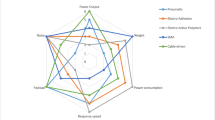Abstract
The design of gripper jaws for the concentric handling of tapered components is investigated. The jaws have specially shaped profiles made up of a series of curves resembling the Greek character ‘v’, stacked one on top of another. The equations for the profiles are derived. The geometrical parameters affecting their dimensions and shapes are identified. The selection of values for the parameters to yield optimum profiles is discussed.
Similar content being viewed by others
Abbreviations
- c 1 (C u):
-
point of contact between the component and the lower (upper) part of the jaw profile
- F :
-
partial rate of change ofr with respect toL
- G(θ):
-
that part of the functionr(θ,L) which is independent ofL (value ofr whenL=0)
- k :
-
constant
- k 1 :
-
rate of change ofF with respect to θ (F assumed to be a linear function of θ)
- k 2 :
-
value ofF when θ=0
- L :
-
component length
- m 1 (m u):
-
a point on the lower (upper) part of the jaw profile
- r, r(θ,L):
-
component radius
- R :
-
length of gripper finger
- X C 1,Y c 1 :
-
coordinates ofc 1
- X c u,Y c u :
-
coordinates ofC u
- X m 1,Y m 1 :
-
coordinates ofm 1
- X m u,Y m u :
-
coordinates ofm u
- α:
-
jaw angle (angle between jaw contact lines)
- β:
-
half taper angle
- ϕ 1(ϕ u):
-
lower (upper) contact angle (angle between the lower (upper) jaw contact line and the axis of symmetry of the gripper)
- ρ 1(ρ u):
-
radius of curvature of the lower (upper) jaw profile
- ψ:
-
opening angle of gripper finger
- θ:
-
angle between the plane of symmetry of the gripper and the plane containing the axes of the gripped component and the pivot of the gripper finger. (The gripper finger could be considered as fixed at the position where the jaw profile contacts the largest component to be gripped, the actual gripped component could be regarded as sliding along the arc normally swept by the finger-tip.) θ is also the angle by which the gripper finger rotates when changing from gripping the largest component to gripping a given component
References
D. T. Pham and S. H. Yeo, “CAD/CAM of jaws for robot grippers”,Proceedings of 25th International Machine Tool Design and Research Conference, Birmingham, pp. 213–221, April 1985.
D. T. Pham and S. H. Yeo, “Quasi-parallel grippers for the concentric handling of cylindrical workpieces”,International Journal of Advanced Manufacturing Technology,1(1), pp. 95–120, September 1985.
D. T. Pham and W. B. Heginbotham (eds.),Robot Grippers, IFS (Publications), Bedford, pp. 229–261, 1986.
A. Jeffrey,Mathematics for Engineers and Scientists, Nelson, London, p., 525, 1971.
M. J. Nategh, “Flexible forming-machining manufacturing cell”, PhD thesis, University of Birmingham, 1988.
Author information
Authors and Affiliations
Rights and permissions
About this article
Cite this article
Pham, D.T., Nategh, M.J. CAD of devices for gripping tapered components. Int J Adv Manuf Technol 4, 369–383 (1989). https://doi.org/10.1007/BF02604336
Accepted:
Issue Date:
DOI: https://doi.org/10.1007/BF02604336




